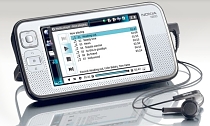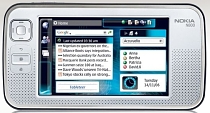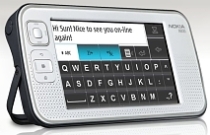New Nokia N800 Internet Tablet available now
Jan 6, 2007 — by LinuxDevices Staff — from the LinuxDevices Archive — 2 views [Updated Jan. 9] — Nokia quietly began delivering an upgrade to its Linux-based 770 Internet Tablet just prior to CES. The Nokia N800 Internet Tablet is available now from at least two retail stores in the U.S., priced at $399.99, CompUSA's Chicago “superstore” has confirmed.
[Updated Jan. 9] — Nokia quietly began delivering an upgrade to its Linux-based 770 Internet Tablet just prior to CES. The Nokia N800 Internet Tablet is available now from at least two retail stores in the U.S., priced at $399.99, CompUSA's Chicago “superstore” has confirmed.

digg this story |
Rumors of an update to the 770 first surfaced last October, when Nokia registered the new device with the FCC (Federal Communications Commission). On Jan. 6, a set of high resolution photos of the new N800 appeared to Flickr, a popular photo hosting website. One of the photos showed a CompUSA tag on the box, bearing CompUSA part number 344047.













Nokia's N800 Internet Tablet comes “out of the box”
(Full resolution versions of these thumbnails are available at Flickr.com)
CES update
Nokia officially unveiled the N800 Internet Tablet at the Consumer Electronics Show in Las Vegas on Jan. 8, and launched an N800 area on its US website.




Official Nokia N800 Internet Tablet photos
(Click each image to enlarge)
Differences between N800 and 770 tablets
As had been anticipated, the N800 bears a high resemblance to its older sibling, the 770. Key changes include: addition of a VGA-resolution web cam; microphone moved to a more phone-friendly position; two full-size SD card slots, instead of a single RS-MMC slot; built-in stereo speakers, instead of a single speaker; scroll rocker for web page scrolling; redesigned top-mounted buttons and 5-way cursor pad; built-in stand; and a few mechanical tweaks.
One frequent complaint with the earlier 770 tablet was the device's limited internal memory capacity of 64MB RAM and 64MB available flash. The N800 ups the RAM to 128MB, and increases the flash memory to 256 MB (with around 80 MB reportedly occupied by the device's standard Linux software stack), according to Nokia's director of open source, Dr. Ari Jaaksi. Another significant change is that instead of the 770's single RS-MMC (reduce-sized MMC) slot, the N800 provides a pair of full-sized SD card slots, which Nokia says are usable with SD, MicroSD, MiniSD, MMC, and RS-MMC cards, in capacities up to 2GB. Cards such as RS-MMC require the use of a small adapter.
In addition to substantial memory increases (RAM and flash), the N800's processor speed has also been upgraded, according to Jaaksi. The N800 is based on a TI OMAP 2420 SoC (system-on-chip), rather than the 770's OMAP 1710. While he didn't specify the processor's clock rate, the N800's processor is rumored to be clocked at 320 MHz, as compared to the 770's 220 MHz. The resulting performance enhancement is sure to be appreciated.
The N800 measures 5.7 x 3.0 x 0.5 inches and weighs 7.3 ounces, as compared with 5.5 x 3.1 x 0.7 inches and 8.1 ounces for the 770. The 4.1-inch touchscreen display retains the much-praised 800 x 480 pixels resolution of the earlier model.
Despite changes to the hardware, the N800 has much in common, from a software perspective, with the 770. Details on the 770's software stack are available in our comprehensive Nokia 770 Internet Tablet Device Profile, and information on the 2006 update to the 770's software appears here. The N800's OS, meanwhile, is dubbed “Internet Tablet OS 2007 edition.” Presumably an OS 2007 version for the 700 tablet will also be forthcoming.
According to Jaaksi, key differences between the N800's OS 2007 Linux software stack and the 770's OS 2006 include:
- Updated Opera 8 browser
- Vidoecalls
- Proper podcast support
- Unspecified UI improvements
- Intelligent connectivity that remembers how you want to get connected
“…and many others.”
In other news, a Nokia development team in Brazil recently created a nifty finger-driven music player for the 770 Internet tablet and likely the N800 also. The “Canola” application combines UPnP renderer and control point functionality, enabling it to transparently detect UPnP repositories such as consumer NAS devices, and then index and render/play their photo, music, and video resources.
Also, 802.11 specialist DeviceScape recently launched a software utility and service capable of automating WiFi logins at thousands of commercial hotspots.
Lots more Nokia 770 and N800 stories can be found in the related stories list below.
This article was originally published on LinuxDevices.com and has been donated to the open source community by QuinStreet Inc. Please visit LinuxToday.com for up-to-date news and articles about Linux and open source.
